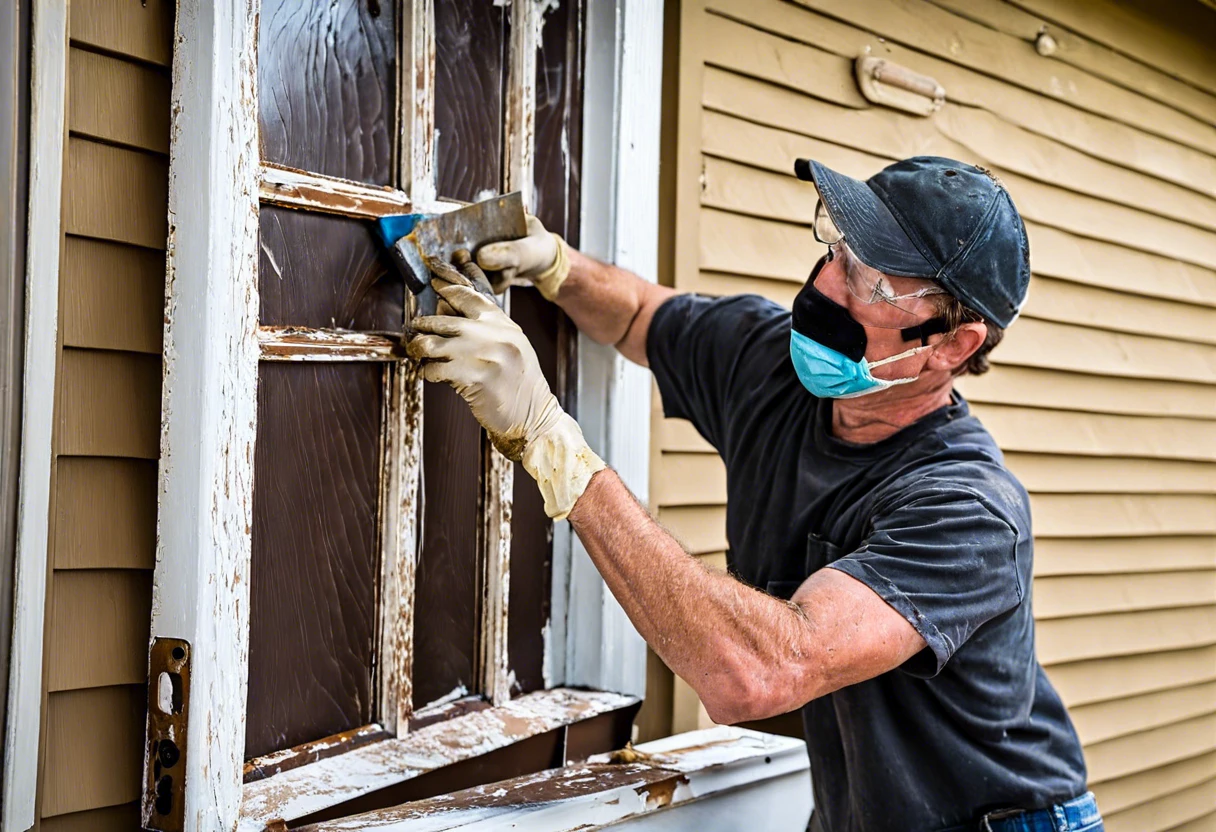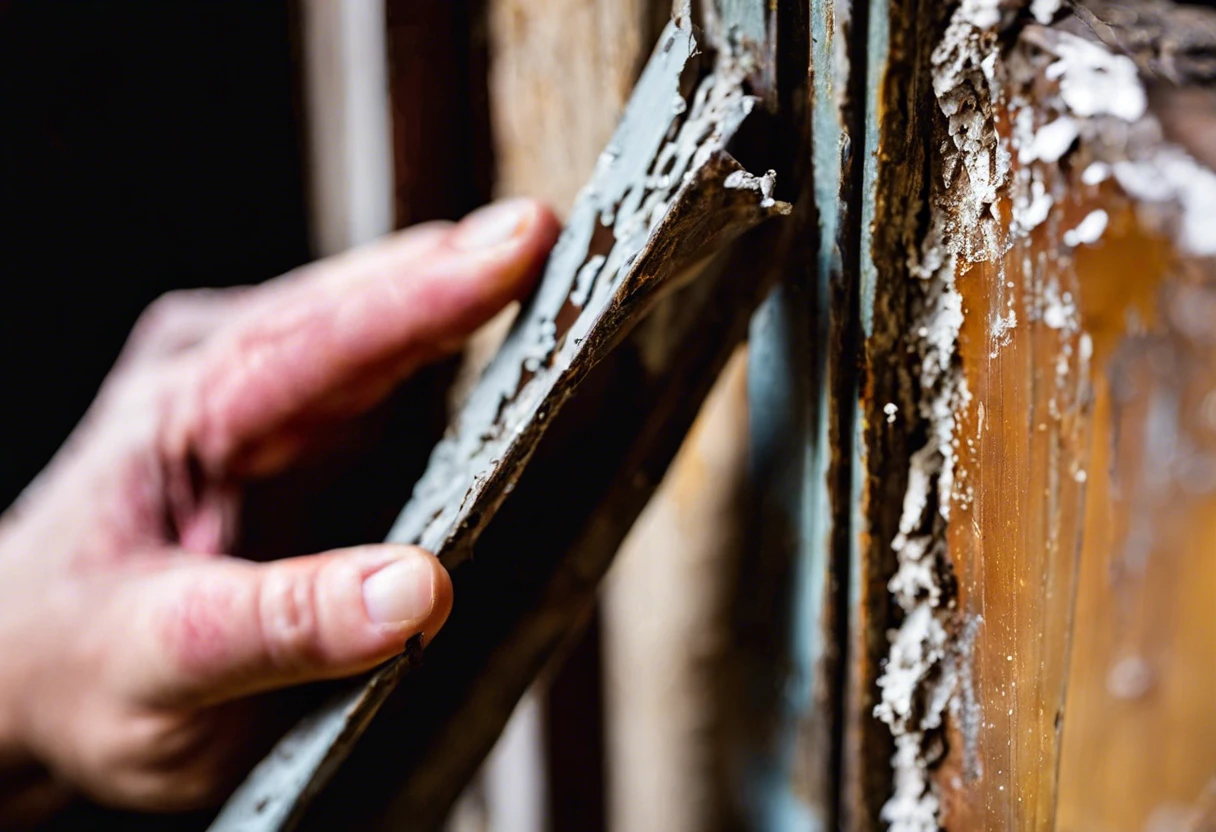Can You Remove Lead Paint Myself?
Published on: February 23, 2025 | Last Updated: January 7, 2025
Written By: Isabella Cruz
Lead paint is a type of paint that has lead in it. It was used a long time ago, and it’s harmful, especially to kids.
So, can you remove lead paint yourself? It’s important to know because lead paint can cause health problems, and dealing with it safely is a big deal. I once tackled a small project and learned that following the right steps can make all the difference.
In this guide, we’ll cover what lead paint is, essential preparations before you start, step-by-step removal tips, various techniques, and common problems you might face. You’ll also find innovative project ideas after removal and answers to frequently asked questions related to how to deal with lead paint.
Contents
- 1 Can You Remove Lead Paint Yourself?
- 2 What is Lead Paint?
- 3 Essential Preparations Before You Start
- 4 Step-by-step Guide to Removing Lead Paint
- 5 Types Of Lead Paint Removal Techniques
- 6 Factors Affecting Lead Paint Removal Success
- 7 Common Issues Encountered When Removing Lead Paint
- 8 Health Risks of Lead Exposure During Removal
- 9 Cost Considerations for DIY Lead Paint Removal
- 10 Local Regulations and When to Hire a Professional
- 11 Finishing Touches After Lead Paint Removal
- 12 Frequently Asked Questions About Lead Paint Removal
- 13 Conclusion
- 14 Useful Resources
Can You Remove Lead Paint Yourself?
Yes, you can remove lead paint yourself, but it’s risky and requires safety gear. Always test for lead first. If found, consider methods like encapsulation or hire a pro. When thinning paint for safer removal, you might want to learn proper paint thinning techniques. Safety comes first; don’t take chances!
The Finishing Touch
A freshly painted wall is a blank canvas. The best way to bring your room to life is with a single piece of statement art that ties everything together.
Browse Wall Art at Big Wall DecorWhat is Lead Paint?
Lead paint contains lead, a toxic metal. It was widely used until the U.S. banned it in 1978. Around 24 million homes still have lead-based paint, especially those built before 1960.
You might wonder if you can remove lead paint yourself. I’ve done this at home, and it’s a bigger task than it seems. Safety precautions are essential!
While working on an old Victorian house, I learned the proper methods to test for lead paint. Identifying lead paint is crucial before considering projects like removing lead paint from wood or deciding whether to paint over existing surfaces safely.
Essential Preparations Before You Start
What do you need to take care of?
- Lead Paint Test Kit: You’ll need a kit like the 3M LeadCheck to determine if your paint contains lead, ensuring a safe start.
- Protective Gear: Get gloves like Nitri-Solve and a certified respirator, such as the 3M 6000. They’re crucial for protecting you from lead dust.
- Plastic Sheeting: Use durable options like Everbilt 6 mil heavy-duty plastic, measuring 10 ft x 25 ft (3 M X 7.6 M), to contain dust and debris while you work.
- Trash Bags: Use heavy-duty bags, like Glad ForceFlex, to safely dispose of lead-contaminated materials and prevent pollution.
We’ve wrapped up key preparations before you start. Let us turn our attention to the step-by-step process for removing lead paint.
Also See: Can Dogs Die From Paint Fumes? Protect Your Pet!

Step-by-step Guide to Removing Lead Paint
Here are the essential steps for DIY lead paint removal.
The Finishing Touch
A freshly painted wall is a blank canvas. The best way to bring your room to life is with a single piece of statement art that ties everything together.
Browse Wall Art at Big Wall Decor-
Conduct Testing for Lead
Before starting, test the surface with a lead paint test kit, which costs around $10–$30. If the surface shows lead above 1 mg/cm², you’re dealing with lead paint.
Act fast! Addressing lead paint issues is crucial for your health and safety. You might think you’ll get lucky—but that’s unlikely!
-
Gather Necessary Safety Gear
You need a fitted N95 respirator, safety goggles, and heavy-duty gloves. These items protect you from harmful dust and particles, so don’t skip this!
Invest between $50 and $100 in quality safety gear to protect your health while removing lead paint.
-
Prepare the Area for Lead Paint Removal
Isolate the space by closing windows and doors. Cover floors with plastic sheets to catch dust and paint chips.
Seal off vents and any other openings to prevent lead dust from spreading. This may take some time, but it’s worth it for safety!
-
Choose the Right Removal Method
Use wet scraping or chemical strippers specifically designed for lead paint. A quality chemical stripper costs $20 to $50 and can significantly reduce dust risk.
Wet scraping is more effective at controlling dust, leading to less clean-up hassle!
-
Proper Disposal Of Lead Paint Waste
Dispose of collected debris in clearly marked bags compliant with local hazardous waste laws. Some areas require treating lead paint waste as hazardous material, so you may need to drive it to a facility—plan accordingly! If you’re considering alternative painting techniques like murals, painting techniques and tips can help guide your project.
Always check local disposal guidelines to avoid fines. Following recommended actions helps you avoid headaches later.
That covers the step-by-step process for lead paint removal. Let’s now take a look at various techniques for removing lead paint.
Types Of Lead Paint Removal Techniques
Let’s explore the types: scraping, sanding, chemical stripping, and encapsulation.
-
Scraping
Scraping is a direct method for removing lead paint. It’s recommended for small, flat areas like windowsills, using a handheld scraper to remove layers.
-
Sanding
Sanding uses a power sander or sandpaper to remove lead paint. Wear a mask; lead dust is dangerous, so monitor dust levels.
-
Chemical Stripping
Chemical stripping uses special solvents to dissolve paint. It’s effective for intricate details but requires careful handling; follow safety recommendations.
-
Encapsulation
Encapsulation covers lead paint with a special coating that seals it. This method is useful if you prefer not to remove the paint yourself.
From my experience, encapsulation is a practical approach if you’re concerned about lead dust. It’s simple and requires less labor, making it a smart choice for many homeowners.
That covers various techniques for lead paint removal. Let’s now take a look at factors influencing the success of removal.
Factors Affecting Lead Paint Removal Success
What factors impact your ability to safely remove lead-based paint from your home?
-
Condition of the Paint – Flaking or chipping paint increases the risk during removal.
-
Your Experience Level – Skilled individuals handle removal tasks more safely and efficiently.
-
Use of Correct Tools – Having the right tools ensures a safer approach to lead paint removal.
-
Proper Safety Precautions – Using protective gear significantly reduces health risks during lead paint removal.
You should now have a good understanding of factors influencing lead paint removal effectiveness. In the next part, we’ll discuss common challenges faced during the process.

Common Issues Encountered When Removing Lead Paint
When my friend tried to remove lead paint herself, she didn’t wear a proper mask. That was dangerous! Lead dust can linger and affect health over time.
To fix this, I suggested using a HEPA filter vacuum that captures particles as small as 0.3 µm. Always seal off rooms with plastic sheeting for safety.
Health Risks of Lead Exposure During Removal
Understanding the health risks is crucial when removing lead paint yourself.
- Short-term Effects: Symptoms include headaches, dizziness, and stomach pain. You might experience fatigue, irritability, or nausea within days of exposure.
- Long-term Effects: Prolonged exposure can lead to serious issues like memory loss and nervous system damage. Kids are especially vulnerable, as lead can affect brain development.
- Immediate Actions: If you experience symptoms, consult a healthcare professional right away for a blood lead level test. Prompt action is essential!
Cost Considerations for DIY Lead Paint Removal
Calculating the costs helps you plan wisely for the project.
| Item | Estimated Cost (USD) |
|---|---|
| Lead Paint Test Kit | $10 – $30 |
| Protective Gear | $50 – $100 |
| Chemical Stripper | $20 – $50 |
| Disposal Bags | $5 – $15 |
| HEPA Vacuum | $100 – $200 |
| Total Estimated Cost | $285 – $595 |
Keep these costs in mind as you plan your project. Knowing your budget helps avoid surprises.
The Finishing Touch
A freshly painted wall is a blank canvas. The best way to bring your room to life is with a single piece of statement art that ties everything together.
Browse Wall Art at Big Wall DecorLocal Regulations and When to Hire a Professional
It’s wise to know the local laws about lead paint removal.
- Local Regulations: Many regions require you to follow specific guidelines for lead paint disposal. Check with your local health department for rules in your area.
- When to Hire a Professional: Consider hiring a pro if you’re unsure about safety practices, the area is large, or lead levels are high. The cost might range from $8 to $15 per square foot depending on the complexity of the job.
- Professional Benefits: Pros have training and specialized gear. They ensure compliance with regulations, reducing your stress.
Finishing Touches After Lead Paint Removal
After the challenging task of lead paint removal, rinse all surfaces with a damp cloth. Use a HEPA vacuum to clean up any remaining dust for added safety.
Inspect the area with lead testing kits like 3M Lead Check. Ensure all surfaces are clean; any residual lead dust can pose a health risk. Check thoroughly around 20 cm (8 Inches) from the edges of surfaces. If you’re preparing for a painting project and want to ensure proper surface preparation, master your painting techniques to achieve professional results.
I recommend sealing floors with a composite sealer like Rust-Oleum’s EpoxyShield to lock in any remaining lead paint particles. Do this for extra protection.
For experienced home renovators, consider using a laser distance meter to assess lead content on surfaces. Measure lead contamination in μg/cm² for precise readings after remediation.
Frequently Asked Questions About Lead Paint Removal
What Are the Legal Requirements for Lead Paint Removal?
Yes, there are legal requirements for lead paint removal. You typically must follow the US EPA’s Renovation, Repair, and Painting (RRP) Rule, which applies to homes built before 1978. This ensures you use certified professionals and safe methods, as failing to comply may result in fines up to $37,500 per violation.
What Tools Do I Need for Lead Paint Removal?
To remove lead paint, you’ll need specific tools like a HEPA vacuum, lead-safe work practices, and protective gear, including respirators. These are crucial because lead particles are harmful. A basic kit can cost around $100, ensuring you stay safe while tackling this issue. If you’re uncertain about proper painting techniques or surface preparation, professional painting methods can provide additional guidance for safe and effective paint removal.
How Can I Dispose Of Lead Paint Safely?
To dispose of lead paint safely, you should contact local waste management. They often have guidelines for treating hazardous paint health protocols. Failing to follow disposal rules can lead to serious environmental contamination and health risks, so knowing the right steps prevents legal issues and public harm. If you’re curious about preparing paint surfaces, you might want to explore painting techniques for different materials.
What Should I Do if I Suspect Lead Poisoning?
If you suspect lead poisoning, get a blood test done immediately. Symptoms can be severe, including stomach pain and developmental delay. The CDC suggests that children with blood lead levels of 5 micrograms per deciliter (Μg/dl) or higher should receive follow-up care. Many environmental factors contribute to lead exposure, and understanding the historical context of traditional paint’s toxic legacy can help prevent future contamination.
How Do You Get Rid Of Lead Paint Effectively?
To get rid of lead paint effectively, you need to use safe methods like encapsulation or professional removal. Removal takes specialized equipment to avoid health risks. Professional methods often cost around $8 to $15 per square foot but ensure safety for you and your family. If you’re wondering about paint dilution techniques during the removal process, you might want to explore paint mixing strategies.
Conclusion
I hope this provided you with the information you were looking for. We discussed what lead paint is, essential preparations, a step-by-step removal guide, recommended color palettes, removal techniques, factors influencing success, common issues, finishing touches, and innovative DIY project ideas.
I trust these insights will be helpful. So, can you remove lead paint yourself? Yes, with the right preparation, tools, and methods, you can do so safely and effectively. Just keep in mind to protect yourself and adhere closely to the outlined steps.
For more insights on effective removal techniques, explore Paint Answers.
Useful Resources
- Smith, R. (2003). The Artist’s Handbook of Materials and Techniques (5th ed.). New York, NY: Knopf.
- How to Remove Lead Paint (Homeowner’s Guide) – Bob Vila
- DIY Paint Removal — LEAD OUT® Paint Stripper: Safe lead paint removal
Isabella is a Filipino-American art writer and critic specializing in contemporary painting, blending her Filipino heritage with global art trends. She holds a BFA from California State University, Long Beach, and a Minor in Art History from the University of the Philippines. Isa has experience as a Gallery Assistant, Art Appraisal Specialist, and Social Media Creative for Art & Design.
Health, Misc.
Also See: What Temperature Can You Not Paint Outside? Guidelines









